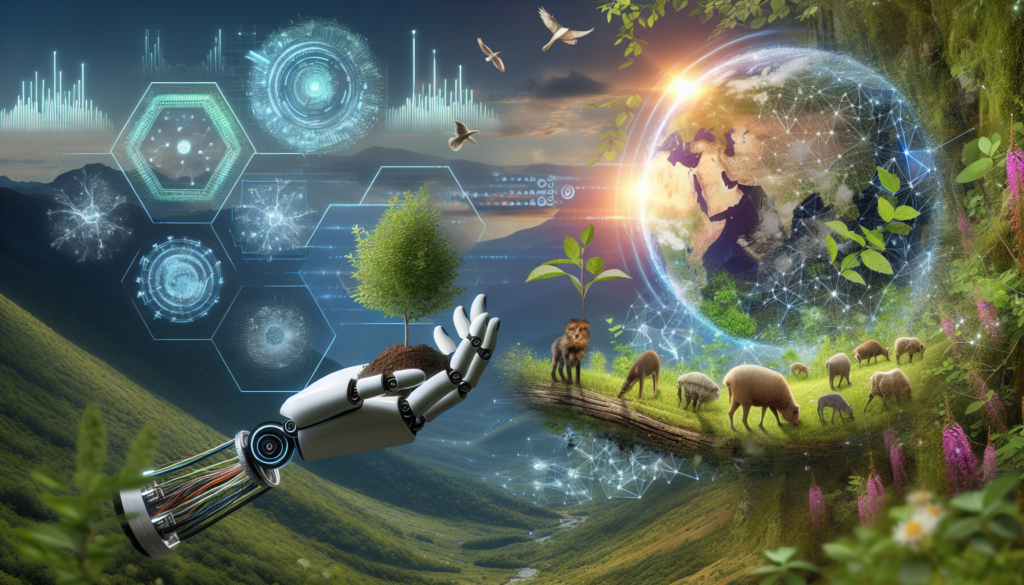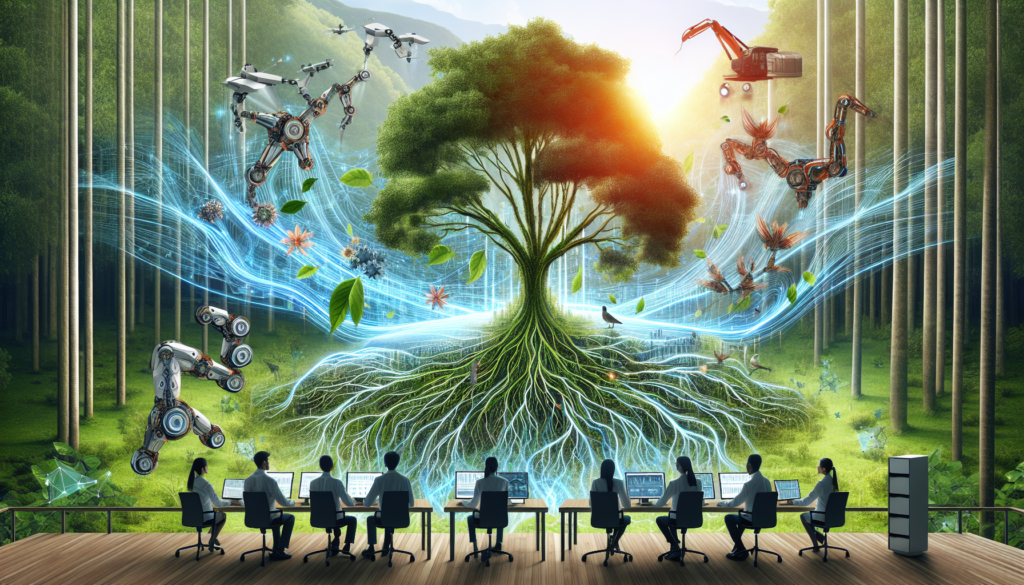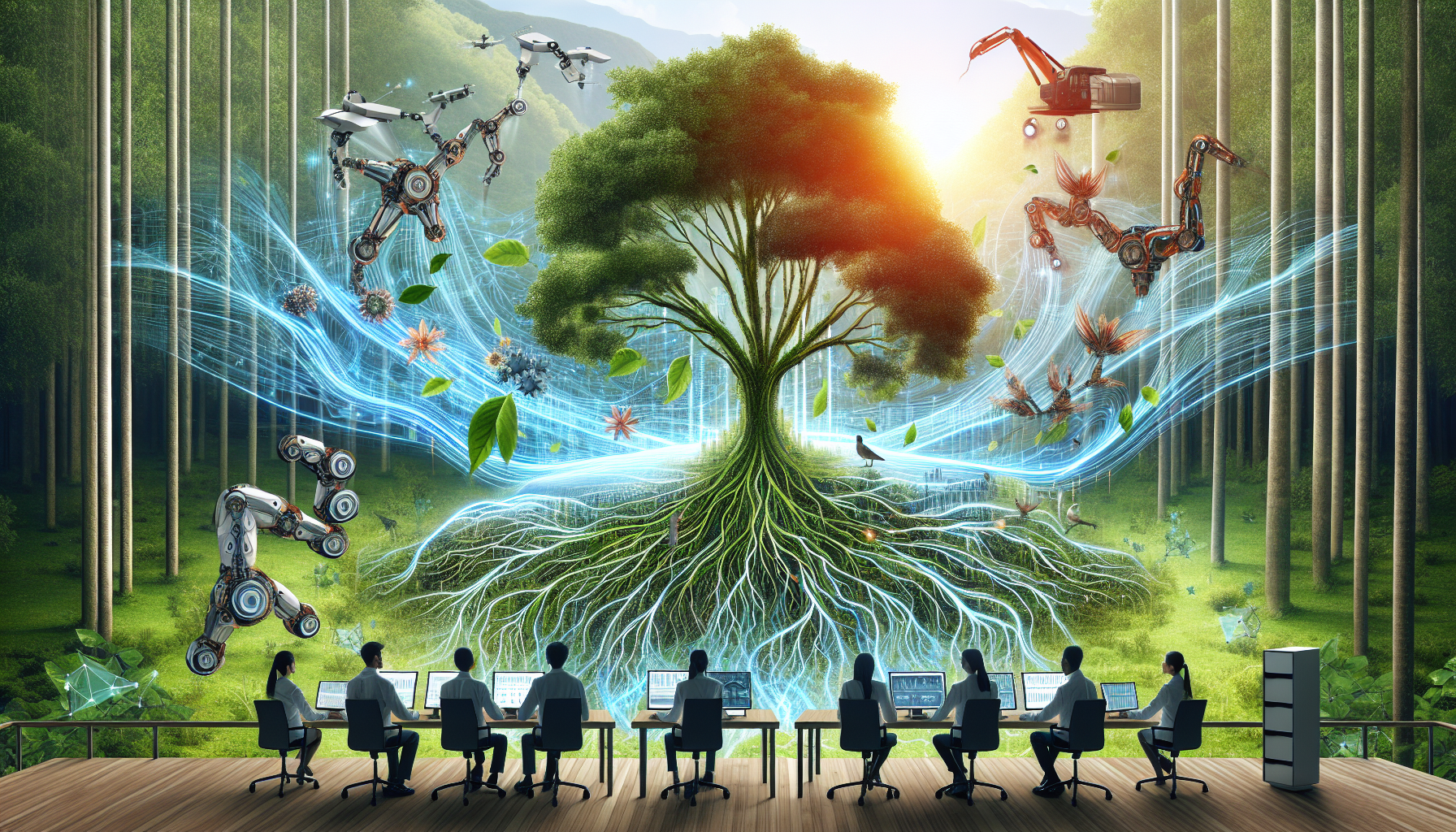In today’s rapidly advancing world, the concept of environmental conservation has become more important than ever. As the world’s population grows, so does the pressure on our natural resources and ecosystems. Thankfully, there is a groundbreaking solution on the horizon – Artificial Intelligence (AI). AI has emerged as a powerful tool in the fight against environmental challenges, offering innovative solutions that can aid in the preservation and restoration of our planet. By harnessing the capabilities of AI, we can strengthen our efforts towards sustainable development and create a more environmentally-friendly future.

Benefits of Artificial Intelligence in Environmental Conservation
Reducing Carbon Footprint
Artificial intelligence (AI) plays a crucial role in reducing the carbon footprint and combating climate change. By analyzing vast amounts of data, AI algorithms can identify patterns and make predictions that help optimize energy usage and minimize greenhouse gas emissions. For example, AI-powered smart grids can efficiently distribute electricity, ensuring minimal waste and reducing the need for fossil fuel-based power generation. Moreover, AI algorithms can help in the development of renewable energy systems, making them more efficient and cost-effective.
Optimizing Energy Consumption
Another significant benefit of AI in environmental conservation is optimizing energy consumption. AI technology can analyze real-time data from various sensors and devices, enabling proactive energy management. For instance, machine learning algorithms can learn from patterns in energy demand, historical consumption data, and weather patterns to anticipate peak loads. By accurately predicting when and where energy will be needed, AI can help utilities distribute power efficiently, leading to reduced energy waste and lower greenhouse gas emissions.
Managing Waste
AI systems can revolutionize waste management practices, making them more efficient and sustainable. Through image recognition and machine learning algorithms, AI can help sort and categorize different types of waste with incredible precision. This enables the recycling process to become automated and streamlined, reducing human error and increasing the recycling rates. Additionally, AI’s ability to analyze waste data from various sources can help identify areas where waste is being generated excessively and suggest strategies for reducing waste generation.
Monitoring and Protecting Wildlife
The use of AI in monitoring and protecting wildlife is a game-changer for environmental conservation efforts. AI-powered cameras and sensors can be deployed in remote areas to monitor wildlife populations, track migrations, and detect threats. Machine learning algorithms can analyze vast amounts of data from these devices, allowing researchers and conservationists to gain invaluable insights into animal behavior, habitat conditions, and potential risks. By effectively monitoring wildlife, we can take timely action to protect endangered species, prevent poaching, and preserve delicate ecosystems.
Predicting Natural Disasters
AI’s predictive capabilities have far-reaching implications for anticipating and mitigating the impact of natural disasters. By analyzing historical data and real-time information from satellites, weather stations, and other sources, AI algorithms can identify patterns and make accurate predictions regarding the occurrence and intensity of natural disasters. This information enables early warnings, facilitating proactive measures such as evacuation planning, resource allocation, and disaster response coordination. With AI’s help, communities can better prepare for natural disasters, potentially saving lives and minimizing the damage to infrastructure and the environment.
Challenges and Concerns
Ethical Considerations
While AI has immense potential in environmental conservation, it also raises ethical considerations. For instance, the use of AI algorithms for decision-making related to wildlife management and habitat conservation may involve difficult ethical trade-offs. Determining the appropriate balance between human intervention and nature’s autonomy can be a complex and controversial issue. Additionally, there is a need to address the potential biases and unintended consequences that AI algorithms may introduce when applied to environmental conservation, ensuring that decision-making is fair and in line with conservation goals.
Privacy Issues
The increased use of AI in environmental monitoring and data analysis raises concerns regarding privacy. AI systems rely on vast amounts of data to train and improve their algorithms, which may include personal or sensitive information. It is crucial to establish robust data protection measures to ensure that individuals’ privacy is upheld while harnessing AI’s potential for environmental conservation. Strict regulations and policies need to be in place to govern the collection, storage, and use of data, ensuring that it is done in a transparent and responsible manner.
Lack of Personal Connection
One challenge associated with the use of AI in environmental conservation is the potential loss of personal connection with nature. As humans, our emotional connection with the environment is vital for driving actions towards conservation. AI technology may inadvertently reduce the direct human experience and appreciation of nature, as it relies on data analysis and automation. It is important to strike a balance between leveraging AI’s capabilities while ensuring that individuals maintain a personal and emotional connection with the natural world.
Job Automation
The integration of AI in environmental conservation may also lead to concerns about job displacement and the future of employment in the field. As AI systems become more proficient in data analysis and decision-making, certain tasks traditionally performed by humans may be automated. This could potentially impact the workforce, particularly in areas like waste management or wildlife monitoring, where AI can perform tasks more efficiently and cost-effectively. It becomes essential to invest in retraining and reskilling programs to transition impacted workers into new roles, ensuring a just and inclusive transition.
Examples of AI applications in Environmental Conservation
Smart Grids
Smart grids are an excellent example of AI’s application in environmental conservation. By leveraging AI algorithms, smart grids can intelligently manage electricity distribution, optimizing energy consumption and reducing greenhouse gas emissions. AI can analyze energy usage patterns, predict demand, and adapt power generation and distribution accordingly. This enables the integration of renewable energy sources into the grid, increases efficiency, and reduces reliance on fossil fuels.
Precision Agriculture
AI-powered precision agriculture is revolutionizing the farming industry. By analyzing data from sensors, drones, and satellite imagery, AI algorithms can provide farmers with insights regarding soil health, crop growth, and pest infestation. This information allows farmers to make data-driven decisions on optimizing irrigation, fertilization, and pesticide application, leading to reduced resource wastage, increased crop yields, and minimized environmental impact.
Smart Waste Management Systems
AI can optimize waste management by enabling smart waste management systems. Through the use of sensors and AI algorithms, waste collection routes can be optimized, reducing fuel consumption and emissions from waste collection trucks. Additionally, AI can analyze data on waste generation and recycling rates to identify areas for improvement, such as implementing targeted recycling education campaigns or introducing incentives for recycling.
Bioacoustic Monitoring
Bioacoustic monitoring is a valuable application of AI in wildlife conservation. AI algorithms can analyze audio recordings to identify different species’ vocalizations and track their populations. This technology allows for better monitoring of elusive and endangered species, contributing to their preservation. Moreover, AI-powered bioacoustic monitoring can also detect and identify illegal activities such as poaching or logging, aiding in the prevention and mitigation of environmental crimes.
Climate Change Modeling
AI plays a crucial role in climate change modeling, helping researchers analyze complex climate data and make predictions regarding future scenarios. AI algorithms can process vast amounts of historical climate data, satellite imagery, and oceanic data to identify trends and patterns, facilitating accurate predictions and informing policymakers and scientists. This valuable information enables the development of effective mitigation and adaptation strategies to combat climate change and protect vulnerable ecosystems.
Potential Future Developments
Enhanced Predictive Capabilities
As AI technology advances, its predictive capabilities will become even more sophisticated. AI algorithms will be able to analyze complex datasets with greater accuracy, making highly precise predictions about environmental changes, species behavior, and the impact of climate change. These enhanced predictive capabilities will allow for more effective decision-making and targeted conservation efforts, contributing to more sustainable and resilient ecosystems.
Autonomous Environmental Monitoring
The future of environmental monitoring lies in autonomous systems powered by AI. Drones equipped with AI algorithms can be programmed to monitor and collect data on various environmental parameters, such as air quality, water quality, or habitat conditions. This technology can provide real-time insights into ecosystem health, allowing for timely interventions and proactive conservation measures.
AI-powered Ecosystem Restoration
AI’s potential in ecosystem restoration is immense. By leveraging machine learning algorithms, AI can analyze data on degraded ecosystems, identifying optimal restoration techniques and predicting the most effective interventions. AI can also assist in monitoring restoration progress by analyzing satellite imagery or drones’ data, providing valuable feedback and guidance for ongoing restoration projects.
Collaboration and Knowledge Sharing
AI technology can facilitate collaboration and knowledge sharing among researchers, conservation organizations, and communities. By analyzing vast amounts of data from various sources, AI algorithms can identify knowledge gaps, share insights, and connect stakeholders working towards common environmental conservation goals. This collaboration and knowledge sharing can lead to more efficient and coordinated efforts, ensuring the best possible outcomes for environmental conservation.

Conclusion
Artificial intelligence presents immense opportunities in environmental conservation, offering innovative solutions to address pressing environmental challenges. Through its predictive capabilities and data analysis prowess, AI can optimize energy consumption, reduce carbon footprint, improve waste management practices, protect wildlife, and enable proactive measures in the face of natural disasters. However, alongside these benefits, ethical considerations, privacy issues, the need for personal connection with nature, and the effects of job automation must also be carefully addressed. With continued research, development, and responsible implementation, AI can be a powerful tool in preserving our planet for future generations.

